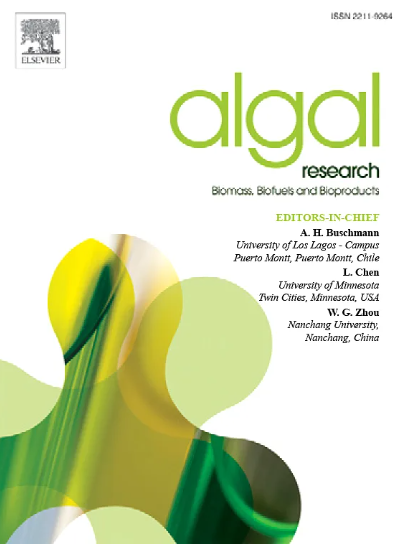C-Phycocyanin mitigates alcoholic liver injury in mice via gut microbiota informatics and liver metabolomics
IF 4.5
2区 生物学
Q1 BIOTECHNOLOGY & APPLIED MICROBIOLOGY
Algal Research-Biomass Biofuels and Bioproducts
Pub Date : 2025-06-07
DOI:10.1016/j.algal.2025.104130
引用次数: 0
Abstract
C-Phycocyanin (C-PC) is a water-soluble natural product used as a blue pigment derived from Spirulina platensis. However, the effects of C-PC on alcoholic liver injury and hepatic metabolism had not been fully explored. In this study, we combined microbiome and metabolomics analyses to explore the effects of C-PC on gut microbiota and hepatic metabolism. Results showed that C-PC dose-dependently reduced alcohol-induced elevations of AST and ALT levels. In addition, C-PC facilitated alcohol detoxification by increasing the activity of ADH and ALDH, as well as antioxidant enzymes such as SOD and reducing MDA levels. C-PC significantly improved the pathological state of the liver in mice and reversed alcohol-induced disturbances in gut microbiota. Moreover, C-PC improved alterations in hepatic metabolites, including characteristic metabolites such as berberine and ponasterone, and modulated key metabolic pathways, particularly nitrogen metabolism. These findings provide a novel approach for the development of innovative hepatoprotective agents utilizing C-PC.
c -藻蓝蛋白通过肠道微生物信息学和肝脏代谢组学减轻小鼠酒精性肝损伤
c -藻蓝蛋白(C-PC)是从螺旋藻中提取的一种水溶性天然蓝色色素。然而,C-PC对酒精性肝损伤及肝脏代谢的影响尚未得到充分的探讨。在本研究中,我们结合微生物组学和代谢组学分析来探讨C-PC对肠道微生物群和肝脏代谢的影响。结果显示,C-PC剂量依赖性地降低了酒精诱导的AST和ALT水平升高。此外,C-PC通过增加ADH和ALDH以及SOD等抗氧化酶的活性和降低MDA水平来促进酒精解毒。C-PC显著改善了小鼠肝脏的病理状态,逆转了酒精引起的肠道微生物群紊乱。此外,C-PC改善了肝脏代谢物的改变,包括小檗碱和波纳酮等特征性代谢物,并调节了关键的代谢途径,特别是氮代谢。这些发现为利用C-PC开发创新性肝保护药物提供了新的途径。
本文章由计算机程序翻译,如有差异,请以英文原文为准。
求助全文
约1分钟内获得全文
求助全文
来源期刊

Algal Research-Biomass Biofuels and Bioproducts
BIOTECHNOLOGY & APPLIED MICROBIOLOGY-
CiteScore
9.40
自引率
7.80%
发文量
332
期刊介绍:
Algal Research is an international phycology journal covering all areas of emerging technologies in algae biology, biomass production, cultivation, harvesting, extraction, bioproducts, biorefinery, engineering, and econometrics. Algae is defined to include cyanobacteria, microalgae, and protists and symbionts of interest in biotechnology. The journal publishes original research and reviews for the following scope: algal biology, including but not exclusive to: phylogeny, biodiversity, molecular traits, metabolic regulation, and genetic engineering, algal cultivation, e.g. phototrophic systems, heterotrophic systems, and mixotrophic systems, algal harvesting and extraction systems, biotechnology to convert algal biomass and components into biofuels and bioproducts, e.g., nutraceuticals, pharmaceuticals, animal feed, plastics, etc. algal products and their economic assessment
 求助内容:
求助内容: 应助结果提醒方式:
应助结果提醒方式:


